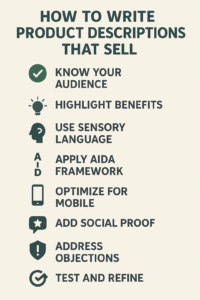To turn casual visitors into loyal customers, practical e-commerce needs product descriptions that sell. It may be done through strategic product writing and intriguing sales copy. Recent research conducted by the Baymard Institute indicates that 87% of online shoppers consider product content to be highly significant in their purchasing decisions. However, many retailers continue to struggle with crafting SEO optimized product descriptions that truly convert.
Simply describing features is insufficient to elevate a product description beyond a subpar standard. Understanding customer psychology, addressing their issues, and crafting narratives that directly align with the desires and requirements of the target audience are essential. Effective e-commerce copywriting integrates conversion optimization techniques with an understanding of consumer behavior to create product listings that drive sales autonomously.
Compelling product descriptions require proficiency in persuasive writing and the application of established sales copywriting techniques that guide customers from interest to purchase.
Understanding the Psychology Behind Effective Product Descriptions
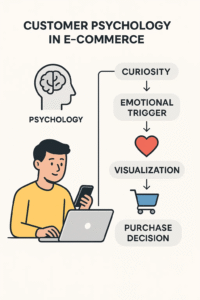
Before discussing the specifics of crafting compelling product descriptions that sell, it is essential to understand the factors that influence online purchasing behavior and e-commerce conversion rates. Online shopping differs from in-person shopping because consumers cannot physically touch, feel, or examine the items. Consequently, they must depend on digital product copywriting and sales copy to transition from curiosity to purchase.
A study by the Nielsen Norman Group indicates that highly converting product copywriting engages emotional triggers while providing logical justification for purchasing decisions. Customers must visualize their use of the product and comprehend its functionality, as well as its potential to enhance their lives or address their pain points.
Compelling benefit-driven product descriptions enable individuals to envision themselves possessing and utilizing the item, a phenomenon referred to by psychologists as ownership visualization. This psychological concept explains why benefit-focused descriptions consistently outperform feature-heavy descriptions in studies concerning conversion rate optimization.
According to Statista, over 54% of all website traffic originates from mobile devices, indicating that contemporary e-commerce copywriting must prioritize mobile optimization and user experience to ensure product descriptions are scannable and engaging on all screen sizes.
The Essential Elements of High-Converting Product Descriptions
Know Your Target Customer and Buyer Personas Inside and Out

Targeted messaging and customized content marketing ensure that each word in your product description effectively communicates with your ideal customer and target audience. This entails conducting comprehensive market research and customer analysis to understand demographics, pain points, purchasing behaviors, and the terminology used to describe their challenges.
Creating detailed buyer personas enables the formulation of high-converting product descriptions that appear personalized and relevant to the target market. Consider factors such as age, income, lifestyle, and, most importantly, the specific issues that your solution resolves for them. For example, a skincare product targeting busy working mothers requires a distinct messaging strategy compared to one aimed at teenagers experiencing acne.
Examine customer reviews, social media comments, and support inquiries to identify the terminology and expressions utilized by your audience. Imitating their manner of speaking enhances the authenticity and relatability of your e-commerce copywriting. Research from Think with Google indicates that brands employing customer language in their sales copywriting experience a 47% increase in interaction and engagement rates.
Focus on Benefits Over Features in Your Product Messaging
Product features describe what your product has or does, whereas product benefits explain how your product will impact the customer’s life and how they will feel about purchasing it. Features represent objective details, whereas benefits reflect the emotional outcomes that clients envision achieving through compelling benefit-driven product descriptions and conversion-focused copywriting.
For example, rather than stating that a laptop features “16GB of RAM and a quad-core processor,” one could articulate that this configuration enables “seamless multitasking, facilitating video editing, simultaneous application usage, and video conferencing without disruptive lag or crashes.” This approach is a core principle in high-converting product descriptions that prioritize benefit-driven copywriting over technical jargon.
Effective e-commerce copywriting addresses the question “So what?” for each feature discussed. Consider the implications of each feature for the customer’s daily life, and focus on discussing those significant effects rather than only the technical details. This perspective aligns with findings from Conversion Rate Experts, which indicate that benefit-focused descriptions can enhance conversion rates by up to 40%.
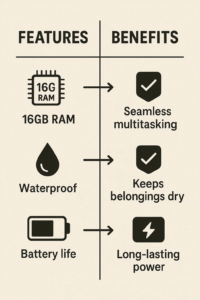
Ready to transform your product descriptions and boost your e-commerce sales? Explore our comprehensive automation services to streamline your entire online selling process.
Use Sensory Language and Emotional Appeals in Your Sales Copy
You cannot physically touch products when shopping online, so your product descriptions that sell need to employ rich sensory language and emotional storytelling that resonates with consumers. Rather than describing a sweater as “soft,” use phrases such as “luxuriously smooth cashmere that provides a gentle embrace against the skin” to create a vivid ownership image and encourage emotional buying triggers.
Color descriptions facilitate interpersonal connections and enhance brand storytelling. Rather than simply using “blue,” consider employing phrases like “calming ocean blue” or “confident navy,” which effectively capture attention in professional settings. These descriptive approaches allow consumers to visualize not only the product itself but also the experience of ownership and the lifestyle it represents.
Emotional appeals remain highly effective, as emotions drive most purchasing decisions despite rational considerations. Research conducted by Harvard Business School indicates that 95% of purchasing decisions occur within the subconscious mind. For example, a vacuum cleaner’s value extends beyond its suction power; it also encompasses the psychological benefits of maintaining a clean home and the peace of mind associated with a healthy living environment.
Structuring Your Product Descriptions for Maximum Impact and Conversion Optimization
The AIDA Framework for Product Copywriting and Sales Funnels
The AIDA model (Attention, Interest, Desire, Action) is a proven method for writing high-converting product descriptions that guide shoppers through the buyer’s journey and improve the overall effectiveness of your ecommerce sales funnel.
Attention should immediately showcase the most compelling feature or unique selling proposition. Start by highlighting the transformative impact of your product rather than using a generic introduction that risks losing the reader’s interest.
To build interest, provide information that is directly relevant to your audience. This part of the description should outline the primary product benefits and integrate key product features that reinforce your claims, giving customers a reason to keep reading.
Creating desire involves helping customers visualize ownership and the positive changes your product will bring to their lives. Use storytelling elements, lifestyle imagery, and social proof such as customer reviews or testimonials. Incorporating these elements makes the benefits feel real and attainable.
Action prompts should be natural and non-intrusive, guiding the reader to the next step while addressing any lingering doubts. Strong yet friendly calls to action, such as “Order today for free shipping” or “Secure yours now,” can improve conversions without sounding pushy.
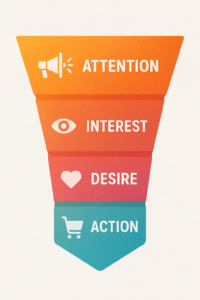
Optimizing for Scannability and User Experience Design
Most online shoppers do not read every word; instead, they scan. To ensure your product descriptions work for this audience, apply UX writing principles that improve readability and flow. Use formatting strategies like bullet points, short paragraphs, and strategic bolding to highlight essential points for today’s time-pressed consumers.
Bullet points can quickly communicate practical benefits and address common customer objections, making them perfect for converting skimmers into buyers. Breaking content into smaller chunks also helps hurried shoppers find the exact information they need without sifting through dense paragraphs.
Organizing content with SEO-friendly subheadings not only helps with search visibility but also makes descriptions more approachable. According to Research from the Nielsen Norman Group, users read in an “F-shape” pattern, meaning strategically placed headings and highlighted keywords are crucial for keeping attention and boosting engagement.
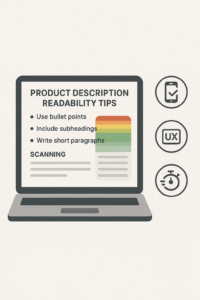
Need help optimizing your product descriptions for better conversions? Contact our experts for personalized guidance on improving your e-commerce copywriting strategy.
Advanced Techniques for Product Description Excellence and Digital Marketing
Storytelling and Social Proof Integration in E-commerce Content
In today’s competitive market, stories create emotional connections that specs for products just can’t match. Rather than listing the ingredients in a skincare product, narrate the process by which the inventor developed the perfect formula after years of experiencing sensitive skin. This method of conveying brand storytelling fosters trust and distinguishes it from competitors.
Incorporating customer tales and testimonials into descriptions offers social proof in product listings and illustrates practical applications in real-world contexts. Expressions such as “customers consistently report” or “our community appreciates this product” enhance authenticity without appearing contrived.
User-generated content, such as customer images and reviews, can be incorporated into descriptions to enhance trust and provide authentic insights regarding the advantages of a product. A study by BrightLocal indicates that 91% of individuals regard internet reviews with the same level of trust as personal recommendations. User-generated content for product pages is a key factor in improving highly converting product descriptions.
SEO Optimization Without Keyword Stuffing for E-commerce Sites
Optimizing product descriptions for SEO and conversions requires balancing keyword research with the creation of content that is accessible to both users and search engines. Utilize long-tail keywords and semantic search terms that reflect consumer search behavior for your products.
Utilize alternative terminology that conveys the same meaning, such as “cord-free listening experience,” “wireless audio solution,” and “Bluetooth connectivity,” rather than repeatedly using the phrase “wireless Bluetooth headphones.” This method appears more organic, increases search queries, and enhances search engine rankings.
Product titles and meta descriptions must incorporate significant keywords while also engaging the audience. It is important to note that search engines increasingly prioritize user experience signals and site engagement metrics. Descriptions that engage readers will achieve higher rankings compared to those that are overly saturated with keywords. John Mueller of Google has consistently stated that information that is beneficial and centered on users performs optimally in search results.
Addressing Common Objections and Concerns
Consider and promptly resolve any uncertainties your customers may possess regarding your product descriptions that sell. Individuals frequently express concerns regarding the item’s longevity, dimensions, compatibility with other products, and overall value for the cost. Proactively addressing these issues reduces friction and fosters trust.
Size recommendations, care instructions, and compatibility information should be integrated into the descriptions rather than presented on separate pages. This comprehensive approach enables consumers to make informed decisions without needing to exit the product site for additional research.
To alleviate concerns regarding purchases, it is effective to promptly present money-back guarantees, warranty details, and return policies. Nevertheless, the comprehensive information should remain in separate sections to avoid obstructing the primary description.
Testing and Optimizing Your Product Descriptions
A/B Testing Different Approaches
Systematic testing reveals the most effective components of the description for the target audience. Experiment with various benefit-driven product descriptions, emotional appeals, and structural techniques to determine which methods produce the highest conversion optimization for product pages.
Commence with significant modifications rather than minor adjustments to terminology. Examine descriptions that highlight benefits as well as those that concentrate on features versus benefits in product descriptions. Experiment with different emotional tones to see which resonates most with your customers.
Monitor additional metrics beyond conversion rates. To evaluate the impact of varied descriptions on consumer engagement throughout the purchase process, track the time spent on product pages, scroll depth, and the number of items added to shopping carts, which helps in improving add-to-cart rates.
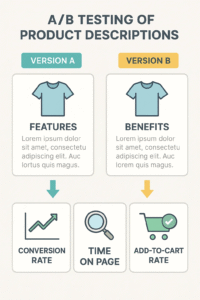
Analyzing Performance and Customer Feedback
Customer reviews often reveal the aspects of your product descriptions that most significantly influence purchasing decisions. Analyze testimonials regarding the advantages derived from the product and its impact on customers’ lives to enhance social proof in product listings.
Customer inquiries and support tickets can highlight gaps in high-converting product descriptions. When customers frequently ask about the same aspects, it may be necessary to clarify or expand those parts of your copy.
Continuous improvement can also be achieved by analyzing sales data combined with customer feedback. It helps identify products that succeed despite weak descriptions and those that underperform even with effective product copywriting strategies, allowing you to refine your writing of product descriptions for an e-commerce approach over time.
For businesses looking to scale their e-commerce operations efficiently, consider exploring professional automation services that can help optimize your entire product catalog while you focus on strategic growth.
Industry-Specific Considerations
Fashion and Apparel Descriptions
Clothing descriptions should provide both stylistic insights and practical information. Customers require details regarding the appearance, fit, visual quality, and mobility of clothing with their bodies.
Employ using sensory language in e-commerce for fabric descriptions to enable customers to visualize the tactile experience of wearing the material. The descriptions must emphasize comfort, durability, and maintenance requirements, supporting high-converting product descriptions. Size information should be comprehensive yet succinct for the primary description.
Styling tips and diverse references enable clients to envision multiple applications of the product, thereby enhancing its perceived value and supporting elevated pricing. Incorporating storytelling in e-commerce can make these descriptions more engaging and persuasive.
Electronics and Technical Products
In the realm of technology products, it is essential to balance technical specifications with consumer advantages. Some clients seek comprehensive details, while the majority are primarily interested in the technology’s potential benefits, highlighting the importance of features vs. benefits in product descriptions.
Compatibility information must be explicit and comprehensive, addressing both software and hardware requirements. Many electronics purchases fail due to compatibility issues that could be mitigated through more thorough product descriptions for e-commerce.
Evaluating performance against previous models or competitors is beneficial; however, the emphasis should be on tangible, real-world improvements rather than technical metrics that may not matter to the average consumer. It aligns with product copywriting strategies that focus on benefit-driven copywriting.
Home and Lifestyle Products
Descriptions of home goods should enable clients to visualize the appearance of the items within their residences. Comparing dimensions to standard room or furniture sizes enhances comprehension beyond mere numerical representation.
Lifestyle benefits generally outweigh utilitarian qualities in the context of home goods. A decorative bowl serves not only as a receptacle for items but also as a means to create spaces conducive to dining and conversation among family and friends. Incorporating social proof in product listings or user-generated content for product pages can further enhance credibility and engagement.
Descriptions must include details about maintenance and care to enable customers to understand the long-term ownership experience and the associated effort required, supporting writing product descriptions that increase sales and reduce post-purchase concerns.
Common Mistakes to Avoid
Generic Template Descriptions
Copying and pasting descriptions that may apply to any similar product does not make your offerings stand out or provide customers with strong reasons to choose your brand over others. Every product description should feel like it was written specifically for that item and the audience who will buy it, following product description best practices for online stores.
Without specific context, words like “high-quality” or “premium materials” do not convey real value. Instead of using generic claims, provide detailed information about construction, materials, and manufacturing processes to demonstrate quality, supporting writing product descriptions that increase sales and high-converting product descriptions.
Overwhelming Technical Jargon
Technical accuracy is important, but excessive jargon can alienate buyers who are not experts in your product category. Translate technical benefits into everyday language that highlights practical advantages, which is a key aspect of persuasive product descriptions.
Give context for technical specifications when necessary. For example, instead of stating “500-thread count cotton,” explain that “500-thread count cotton provides the perfect balance of breathability and luxurious softness that improves with every wash,” aligning with benefit-driven copywriting.
Ignoring Mobile Experience
On mobile devices, many product descriptions that appear effective on desktops can become challenging to read. Test your descriptions across various screen sizes to ensure they remain mobile-friendly product descriptions that are easy to scan and engaging.
Mobile users often have limited attention spans, so front-load the most important benefits and use formatting techniques such as bullet points, concise paragraphs, and clear headings to create scannable product descriptions that reduce cart abandonment and improve overall engagement.
Conclusion
Successful product descriptions that sell require a deep understanding of the target audience, an emphasis on meaningful benefits, and content that resonates with both rational and emotional appeals. Compelling descriptions go beyond providing information; they enable consumers to visualize ownership and foster positive emotions regarding their purchasing decision, which is a core principle of ownership visualization in e-commerce copywriting.
Success demands continuous testing, refinement, and attentiveness to customer feedback. As writing product descriptions for e-commerce evolves, descriptions that prioritize user experience alongside optimizing product descriptions for SEO and conversions will consistently outperform generic, template-driven alternatives.
It is essential to recognize that compelling product descriptions serve not only to drive immediate sales but also to nurture lasting relationships with customers. Consumers who feel informed and confident about their purchases are more likely to become repeat buyers and advocates for your brand, ensuring long-term e-commerce business success.
This guide provides principles that will enhance the effectiveness and engagement of high-converting product descriptions. True success emerges when these strategies are tailored to your specific products, target audience, and brand voice. Implement these product copywriting strategies systematically, evaluate their impact for your audience, and refine your approach based on actual performance data, supporting writing product descriptions that increase sales and reduce cart abandonment.
Ready to transform your product listings into high-converting product descriptions that drive sales? At HiSellIt.com, we provide expert guidance and tools for writing product descriptions for e-commerce, helping you create persuasive product descriptions that engage customers, reduce cart abandonment, and boost conversions. Start optimizing your product descriptions that sell today and turn casual visitors into loyal buyers. Get started now at HiSellIt.com.
Frequently Asked Questions
How long should product descriptions be for optimal conversions?
Product descriptions should be 50-100 words for simple items and 150-300 words for complex products.
Product description length should match customer research needs rather than following arbitrary word counts. Complex or expensive products typically require longer descriptions (150-300 words) to address customer concerns and build confidence, while impulse-purchase or straightforward items often perform better with concise descriptions (50-100 words) that quickly communicate key benefits. The key is providing enough information to overcome purchase hesitations without overwhelming customers with unnecessary details.
What’s the difference between features and benefits in product descriptions?
Features describe what a product has, while benefits explain what those features mean for the customer’s experience.
Features describe what a product has or does (technical specifications, materials, dimensions), while benefits explain what those features mean for the customer’s experience (convenience, satisfaction, problem-solving). For example, “waterproof construction” is a feature, but “keeps your belongings dry during unexpected rain showers” is the benefit. Compelling descriptions lead with benefits that customers care about, then support those benefits with relevant features as proof points.
Should I include pricing information in product descriptions?
No, product descriptions should focus on value demonstration rather than price justification.
Product descriptions should focus on value demonstration rather than price justification, as pricing is typically displayed separately on e-commerce sites. Instead of focusing on cost, highlight the value customers derive from quality, durability, versatility, or unique benefits that justify your pricing. If addressing price-conscious customers, concentrate on cost-per-use calculations or long-term savings rather than defending the upfront investment.
How do I write descriptions for products with multiple variations?
Create a master description highlighting common benefits, then customize specific details for each variation.
Multi-variation products require descriptions that highlight common benefits while allowing for specific differences between options. Focus the main description on shared features and benefits, then use variation-specific details (size, color, capacity) to address discrepancies. Consider creating a master description template that can be customized for each variation while maintaining consistent messaging about core value propositions.
What role do customer reviews play in product description strategy?
Customer reviews provide insights for improving descriptions and reveal which benefits resonate most with buyers.
Customer reviews provide valuable insights for improving product descriptions by revealing which benefits resonate most strongly and which concerns need addressing. Monitor reviews to identify frequently mentioned benefits that should be emphasized in descriptions, as well as common complaints or questions that descriptions should proactively address. Reviews also provide authentic language that customers use to describe products, which can be incorporated into descriptions for better relatability and SEO performance.
